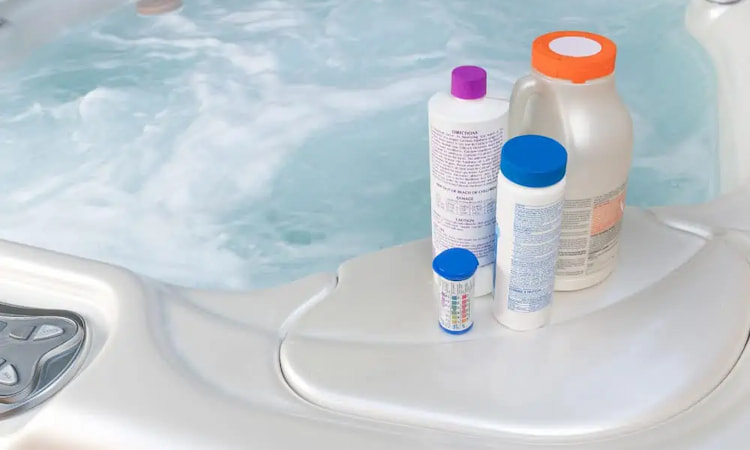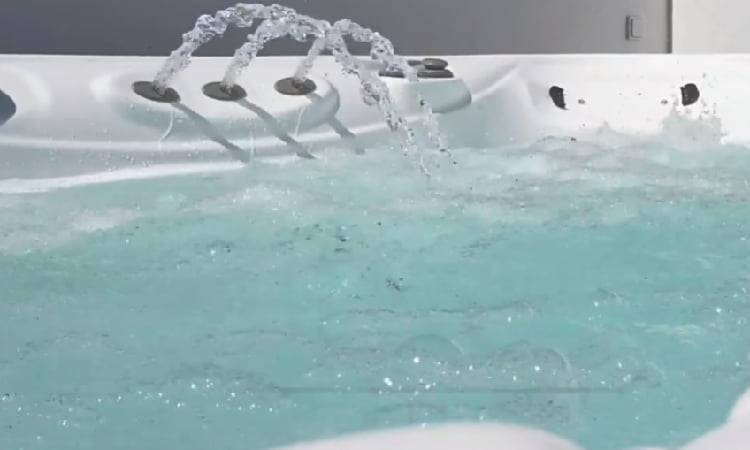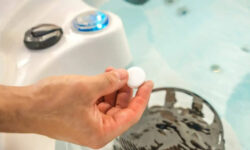You’ve got a hot tub and you’re ready to dive in. But wait, what’s that about free chlorine? In the world of hot tub maintenance, it’s a term you can’t ignore.
Free chlorine in a hot tub refers to the amount of chlorine that is available to sanitize or disinfect the water. It plays a crucial role in killing bacteria, viruses, and other harmful microorganisms to keep the water safe and clean. If the levels of free chlorine are too low, the hot tub may become a breeding ground for bacteria.
So let’s get down to brass tacks. We’ll show you what free chlorine is, why it matters, and how to get it right for your hot tub. Dive in!

Quick Navigation
Understanding Free Chlorine in Hot Tubs
In your quest to maintain a clean and safe hot tub, you’ll likely encounter a significant term: free chlorine. Don’t be intimidated by this technical term. It’s simply the amount of chlorine in your hot tub water that’s available to sanitize or disinfect the water.
When you add chlorine to your hot tub, it doesn’t just float around aimlessly. It gets to work, attacking bacteria, algae, and other contaminants. However, not all the chlorine you add is free to do this job.
Part of it combines with contaminants to form combined chlorine, leaving a smaller portion to do the cleaning. This smaller portion is what we call free chlorine.
So, how much free chlorine should you have? For a hot tub, you’re aiming for between 3.0 and 5.0 parts per million (ppm). Anything less won’t be enough to keep your tub clean, while too much can cause skin and eye irritation.
Importance of Free Chlorine
You can’t underestimate the role free chlorine plays in your hot tub’s health, as it’s your main line of defense against harmful bacteria and algae. This chemical warrior battles against invaders that can make your hot tub not just unappealing, but potentially hazardous to your health.
Health and Safety
- free chlorine combats pathogens, including those that cause illnesses like Legionnaire’s disease and swimmer’s ear.
- it kills algae that can make surfaces slippery, preventing accidents.
Maintenance and Longevity
- it helps keep your hot tub equipment in good working condition by preventing biofilm buildup.
- it prolongs the lifespan of your hot tub, saving you from costly replacements.
Aesthetics and Comfort
- it keeps your hot tub water crystal clear, enhancing your soak experience.
- it prevents unpleasant odors that can disrupt your relaxation.
Measuring Free Chlorine Levels

To ensure your hot tub’s health and safety, it’s crucial to regularly check the levels of free chlorine. You can use a testing kit, which typically includes a color chart and testing strips or drops. Follow the manufacturer’s instructions for the most accurate results.
You’ll need to dip the strip or apply the drops to a water sample, then compare the color change to the chart provided. The ideal level of free chlorine in a hot tub is between 1.0 and 3.0 parts per million (ppm). If the level is below 1.0 ppm, it won’t effectively sanitize your hot tub. Conversely, if it’s above 3.0 ppm, you risk skin and eye irritation.
Remember to test your water before each use and after adding more chlorine or other chemicals. Free chlorine levels can change quickly, especially with heavy use or after rainfall. Don’t forget to adjust the levels as needed, either by adding more chlorine or using a chlorine neutralizer.
Balancing Free Chlorine in Hot Tubs
Maintaining the right balance of free chlorine in your hot tub is an essential aspect of hot tub care.
Getting this balance wrong can lead to a variety of issues that may affect your health and the longevity of your hot tub.
Here’s a quick guide to help you strike the perfect balance:
Understand the Ideal Range: for most hot tubs, the free chlorine level should be between 1.0 and 3.0 parts per million (ppm). You’ll need to adjust accordingly if it falls outside this range.
Regular Testing and Adjustment: test your hot tub’s chlorine levels at least once a week. Use a reliable test kit, and don’t hesitate to adjust the chlorine levels as needed.
Know When to Shock Your Hot Tub: if your hot tub’s been heavily used, or you’ve just refilled it, it’s time for a shock treatment. This involves a larger-than-normal dose of chlorine to kill off bacteria and contaminants.
Common Free Chlorine Issues
Despite your best efforts, there might be times when the free chlorine levels in your hot tub aren’t quite right, leading to a few common issues. Two prevalent problems include high or low free chlorine levels.
Too much free chlorine can cause skin, eye, and respiratory irritation. It can also corrode your hot tub’s equipment. It’s not just a comfort issue; it’s a matter of keeping your hot tub in good working order.
On the other hand, low free chlorine levels leave your tub vulnerable to bacteria and algae growth, as well as cloudy water and unpleasant odors.
If you’re facing these issues, you’ll need to adjust your chlorine levels. High free chlorine levels can be reduced by allowing the tub to sit uncovered, letting the chlorine naturally evaporate. For low levels, adding a chlorinating product should do the trick.
Frequently Asked Questions
Excessive free chlorine in your hot tub can cause skin, eye irritation, and respiratory issues. It’s also linked to hair discoloration. It’s important to maintain balanced chlorine levels for your health and comfort.
As you heat your hot tub, you’re accelerating chlorine’s evaporation rate. This means more free chlorine is lost to the air. So, high temperatures can cause lower chlorine levels, requiring more frequent checks and adjustments.
Yes, free chlorine can damage your hot tub’s equipment and accessories over time. It’s corrosive, so high levels can erode seals, heaters, and even the tub’s shell. It’s vital to maintain balanced chlorine levels.
There’s no specific time of day to add free chlorine to your hot tub. You can do it at any time. However, it’s best to do it when you’re not planning to use the tub immediately.
You should test your hot tub’s free chlorine levels at least twice a week. Frequent testing ensures safe, clean water. Remember, chlorine levels can fluctuate due to usage, temperature, and other environmental factors.
Conclusion
So, you’ve learned about free chlorine’s role in keeping your hot tub clean and safe. It’s crucial to test regularly and balance these levels to avoid issues like skin irritation or algae growth. If you’re struggling, don’t hesitate to seek professional help.
Remember, maintaining your hot tub isn’t just about relaxation; it’s about ensuring a healthy environment for you and your loved ones. Keep those free chlorine levels in check!


![What is a Stabilizer in a Hot Tub? [Types of Stabilizers] what is a stabilizer in hot tubs and how does it work](https://hottubtales.com/wp-content/uploads/2023/10/what-is-a-stabilizer-in-hot-tubs-and-how-does-it-work-250x150.jpg)
![Can You Over Shock a Hot Tub? [What to Do if You Did?] can you over shock a hot tub](https://hottubtales.com/wp-content/uploads/2023/10/can-you-over-shock-a-hot-tub-250x150.jpg)
![How to Lower Bromine Level in Hot Tub? [& Signs of High Levels] how to lower bromine level in hot tub](https://hottubtales.com/wp-content/uploads/2023/10/how-to-lower-bromine-level-in-hot-tub.jpg)

